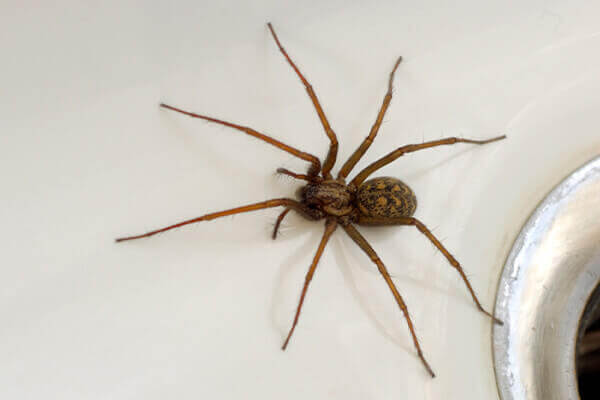House Spider Facts & Information
Everything you need to know about house spiders
What do House Spiders look like

The common house spider gets its name from the fact that it is usually the spider most often encountered indoors. It is a nuisance pest, probably more because of its webs than the spider itself. The house spider is found worldwide and is common throughout the United States and Canada. House spiders vary from grayish brown to dark brown in color and have banded legs. The house spiders’ abdomen is sphere shaped with a pattern of brown and light-beige markings, and two dark colored stripes on the spiders’ head and thorax. They are about 1 inch in length with a 2-inch leg span.
Female house spiders lay about 250 eggs in a silken sac that is brownish in color and round in shape. There may be more than one sac in the web at a time. A female house spider may produce up to 17 sacs, containing a total of more than 3,760 eggs, in her lifetime. The eggs hatch in about 7-10 days. Adults may live for a year or more. Males and females can be found at any time of year, and there are reports of the spiders living for a year or more after maturing. The male and female will coexist in the web and mate repeatedly. If you want to have them taken care of, be sure to bring in a professional to perform house spider extermination that thinks beyond the spiders as well.Not the spider you have?
Female house spiders lay about 250 eggs in a silken sac that is brownish in color and round in shape. There may be more than one sac in the web at a time. A female house spider may produce up to 17 sacs, containing a total of more than 3,760 eggs, in her lifetime. The eggs hatch in about 7-10 days. Adults may live for a year or more. Males and females can be found at any time of year, and there are reports of the spiders living for a year or more after maturing. The male and female will coexist in the web and mate repeatedly. If you want to have them taken care of, be sure to bring in a professional to perform house spider extermination that thinks beyond the spiders as well.Not the spider you have?
Where Are House Spiders Found
The common house spider randomly selects its web sites and creates a tangled web. If a web does not yield prey (food) it is abandoned, another site is selected, and a new web built. Eventually, successful webs are constructed where air currents bring in prey. House spiders have a difficult time surviving in modern homes due to low humidity and fewer insects for food. They are more likely to be found inside structures like garages, sheds, barns and warehouses. Outside, these domestic spiders are often around windows and under eaves, especially near light sources that attract prey. The common house spider may also be found outside under objects such as rocks and boards, as well as beneath bridges and similar structures.
Inside structures, house spiders are most likely to be found in upper corners, under furniture, in closets, angles of window frames, basements, garages, and crawl spaces. In warehouses, they are common in corners near doors that stay open. Because of their web location selection by trial and error, many house spider webs may be constructed in several days. Because this spider frequently abandons its web to build a new one nearby, it can produce many webs in a short period of time. This behavior causes a lot of grief. Dust collecting on these webs accentuates their presence.
Inside structures, house spiders are most likely to be found in upper corners, under furniture, in closets, angles of window frames, basements, garages, and crawl spaces. In warehouses, they are common in corners near doors that stay open. Because of their web location selection by trial and error, many house spider webs may be constructed in several days. Because this spider frequently abandons its web to build a new one nearby, it can produce many webs in a short period of time. This behavior causes a lot of grief. Dust collecting on these webs accentuates their presence.
How Did I Get House Spiders
The presence of house spiders is usually accidental. House spiders may enter structures in search of prey. Although they are not inclined to be permanent residents in structures, they often stay once inside. Any spider can hitch a ride in on a package or someone’s jacket or backpack. And spiders as well as many other pests can squeeze in through cracks and crevices and tears especially if they’re looking for shelter or food. They aren’t associated with cleanliness or lack thereof and they are not a health threat. Doesn’t mean you want them there, though.
What Problems Do House Spiders Cause
Spiders – no matter what species – get a bad rap for just being scary looking. In addition, their webs may be out of reach of your broom, making for an unkempt look in your home or business. All spiders are important to the ecosystem. They are integral in keeping many different pest populations in check – even some spider species! They rarely bother humans and are more afraid of you than you are (or should be) of them. That doesn’t mean you want them in the house or break room with you! If you do have spiders and spider webs, it is an indication that there are other pests (their food) in your home or business. So, be sure to call in a pest control company that will provide spider treatments for spider control but will also expand their services to other pests that are attracting them in the first place.
How Can I Prevent House Spiders
Professional exclusion work can help keep all pests out, including house spiders. Unfortunately, most pests are small, so keeping them out can be difficult. They can scuttle in while you’re bringing the groceries in or if a door is propped open too long. And it doesn’t need to be open for all that long! Once they are in, glue traps can help capture them. But preventing spiders from getting in could be a losing battle. You can minimize with exclusion work and some common sense practices, but to truly take care of nuisances like house spiders, you’ll need a pest control professional.
Why Waltham for House Spider Control
We’re passionate about keeping spiders out of your home or business because we live and work here – it’s our neighborhood, too. With our 130 years of experience keeping homes and businesses in Massachusetts, Connecticut, New York, Maine, Vermont, New Hampshire, and Rhode Island safe from pests, Waltham has the experience you can trust.
Satisfaction Guarantee
24-Hour Guaranteed Response
Board Certified Entomologists
Need help with house spiders?
GET MY QUOTE
“Exceptional service. Prompt and professional. Used for both business and home. Very efficient and honest.”
Agawan, MA
